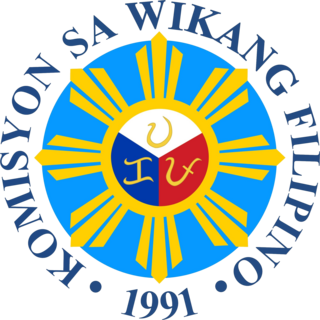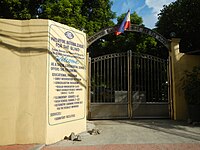
Filipino is a language under the Austronesian language family. It is the national language of the Philippines, and one of the two official languages of the country, with English. It is a standardized variety of Tagalog based on the native language, spoken and written, in Metro Manila, the National Capital Region, and in other urban centers of the archipelago. The 1987 Constitution mandates that Filipino be further enriched and developed by the other languages of the Philippines.

There are some 130 to 195 languages spoken in the Philippines, depending on the method of classification. Almost all are Malayo-Polynesian languages native to the archipelago. A number of Spanish-influenced creole varieties generally called Chavacano along with some local varieties of Chinese are also spoken in certain communities. The 1987 constitution designates Filipino, a standardized version of Tagalog, as the national language and an official language along with English. Filipino is regulated by Commission on the Filipino Language and serves as a lingua franca used by Filipinos of various ethnolinguistic backgrounds.

The Commission on the Filipino Language (CFL), also referred to as the Komisyon sa Wikang Filipino (KWF), is the official regulating body of the Filipino language and the official government institution tasked with developing, preserving, and promoting the various local Philippine languages. The commission was established in accordance with the 1987 Constitution of the Philippines.

The Philippine Statistics Authority is the central statistical authority of the Philippine government that collects, compiles, analyzes, and publishes statistical information on economic, social, demographic, political affairs, and general affairs of the people of the Philippines, as well as enforcing the civil registration functions in the country.
The legal recognition of signed languages differs widely. In some jurisdictions, a signed language is recognised as an official language; in others, it has a protected status in certain areas. Although a government may stipulate in its constitution that a "signed language" is recognised, it may fail to specify which signed language; several different signed languages may be commonly used.

The National Intelligence Coordinating Agency (NICA) is the primary intelligence gathering and analysis arm of the Government of the Philippines in charge of carrying out overt, covert, and clandestine intelligence activities. The NICA directs, coordinates, and integrates all intelligence activities, both foreign and domestic, concerning national security, serving as the leading intelligence collector of the national government, focusing on the country's strategic intelligence requirements. It is mandated to prepare intelligence estimate on local and foreign situation for the formulation of national security policies by the President and the National Security Council.

The Alliance of Concerned Teachers (ACT-Teachers) is a progressive national democratic mass organization of teachers, academics, and other education workers in the Philippines, established on June 26, 1982. It is the largest non-traditional teachers' organization in the country, and campaigns for the economic and political rights of teachers and other education workers as well as on wider social and political issues.

Rodrigo Roa Duterte, also known as Digong, Rody, and by the initials DU30 and PRRD, is a Filipino lawyer and politician who served as the 16th president of the Philippines from 2016 to 2022. He is the chairperson of Partido Demokratiko Pilipino, the ruling political party in the Philippines during his presidency. Duterte is the first president of the Philippines to be from Mindanao, and is the oldest person to assume office, beginning his term at age 71.
Imperial Manila is a pejorative epithet used by sectors of Filipino society and non-Manileños to express the idea that all the affairs of the Philippines, whether in politics, economy and business or culture, are decided by what goes on in the capital region, Metro Manila, without considering the needs of the rest of the country, largely because of centralized government and urbanite snobbery. Empirical research finds that Imperial Manila and its persistence over time has led to prolonged underdevelopment in Philippine provinces.

The Philippine Federation of the Deaf, Inc. (PFD) is a non-stock, non-profit organization which caters to the general needs of deaf people in the Philippines.
The national symbols of the Philippines consist of symbols that represent Philippine traditions and ideals and convey the principles of sovereignty and national solidarity of the Filipino people. Some of these symbols namely the national flag, the Great Seal, the coat of arms and the national motto are stated in the Flag and Heraldic Code of the Philippines, which is also known as Republic Act 8491. In the Constitution of the Philippines, the Filipino language is stated as the national language of the Philippines. Aside from those stated symbols in the Constitution and in Republic Act 8491, there are only six official national symbols of the Philippines enacted through law, namely sampaguita as national flower, narra as national tree, the Philippine eagle as national bird, Philippine pearl as national gem, arnis as national martial art and sport and the Filipino Sign Language as the national sign language. Thus, there is a total of twelve official national symbols passed through Philippine laws.

The Office of the President of the Philippines, is an administrative, advisory, and consultative government agency that aids the president of the Philippines in performing their duty as head of state and chief of the executive branch of government.

Erico Aristotle Cabagnot Aumentado, also known in Bohol as Aris, is a Filipino businessman and politician. He was a member of the House of Representatives, representing the second district of Bohol. He is the Governor of the Province of Bohol, assuming office on June 30, 2022 but was preventively suspended on May 28, 2024 due to the controversial resort construction in the middle of the Chocolate Hills.

American Sign Language (ASL) developed in the United States, starting as a blend of local sign languages and French Sign Language (FSL). Local varieties have developed in many countries, but there is little research on which should be considered dialects of ASL and which have diverged to the point of being distinct languages.
2017 in the Philippines details events of note that happened in the Philippines in 2017.
The following are the events in related to Philippine law in 2016. This includes developments in criminal investigations of national notability.

Rodrigo Duterte's six-year tenure as the 16th President of the Philippines began on June 30, 2016, succeeding Benigno Aquino III. He was the first president from Mindanao, the first president to have worked in all three branches of government, and the oldest to be elected. He won the election amid growing frustration with post-EDSA governance that favored elites over ordinary Filipinos. His tenure ended on June 30, 2022.
The following are the events in related to Philippine law in 2017. This includes developments in criminal investigations of national notability.
The Filipino Sign Language (FSL) is the official language of education for deaf Filipinos, which number around 121,000 as of 2000.
















